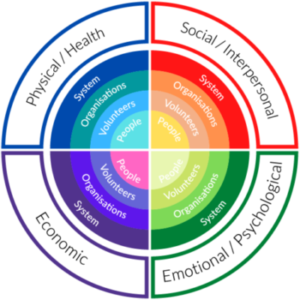Background
Voluntary, community and social enterprise organisations play a key role in our communities and neighbourhoods, supporting our health and care system, and often reaching people that would otherwise be forgotten or who struggle to access services.
This was evidenced by the agility and resilience shown during the initial waves of COVID-19, adapting services and setting up new ones, to support older people isolating at home. Beyond the pandemic, VCSE organisations are also integral to the delivery and success of the social prescribing initiative set out in the NHS Long Term Plan, enabling GPs and other professionals to refer people to a range of local, non-clinical services to support their health and wellbeing.
Previous research (COV-VOL) carried out by the CAVEAT research team showed that many VCSE organisations were concerned about their long term sustainability. They understood the importance of demonstrating the scope and nature of the work they do, the need to show they provide value for money, and that the services they offer are of a high standard and meet the needs of the people they support. However, many lacked the time, resource, and ‘know-how’ to provide this evidence. They wanted to understand what data to collect, how to collect it, and how to use it to demonstrate impact and secure new and on-going funding. Impact evaluation was considered equally important for driving service improvement, offering feedback to the people they support as well as their staff and volunteers.
Introducing the CAVEAT Toolkit

The CAVEAT toolkit can help VCSE organisations to describe, measure and report key information about the difference their service makes to the lives of older people, to their volunteers and their communities. This is particularly useful when looking to sustain existing funding, and also in the process of securing new funding; but also, for quality improvement. Funding bodies or service commissioners will also find the toolkit useful for specifying which outcomes they might like to see demonstrated by providers.
The CAVEAT Outcome Model
CAVEAT toolkit (caveat-toolkit.co.uk)
How to use the toolkit
The project was funded by the NIHR Applied Research Collaboration in Kent Surrey and Sussex.

